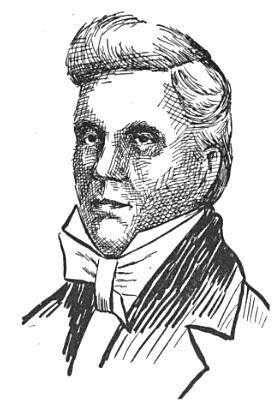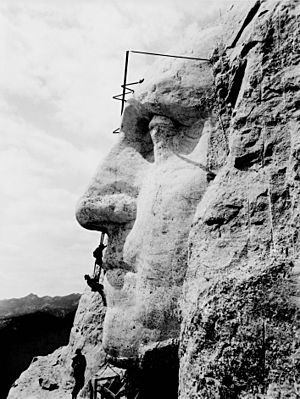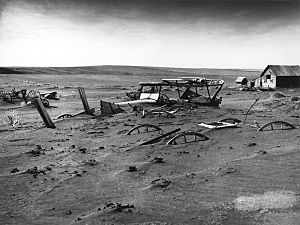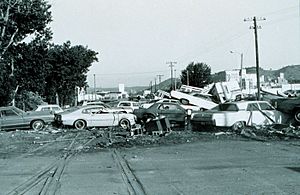Timeline of South Dakota facts for kids
This is a timeline of important events that happened in South Dakota throughout history, listed by year.
Contents
Early People and Ancient Times
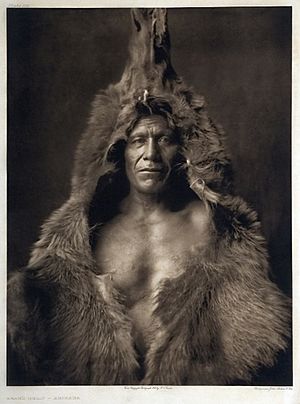
An Arikara man from 1908, wearing a bearskin.
- Long, Long Ago (Before 11,000 BCE): The very first people, called Paleo-Indians, arrived in the Americas. They were part of groups like the Clovis culture.
- Before 8,000 BCE: Another early group, the Folsom tradition, lived here.
- Around 5,000 BCE: The Plains Archaic period started. The weather became drier.
- Starting 3,500 BCE: People known as Mound Builders began living in eastern South Dakota. They built large earth mounds.
**Around 1,100 BCE: The Woodland period began. People started making pottery, textiles, and new tools. The climate became more like it is today, and trade with other groups became common. **Around 1,000 CE (11th Century): Farming began with the Mississippian culture. **1325: A sad event happened at a village near Crow Creek, where many people were killed. **1400s (15th Century): The Arikara and other Plains Village people arrived. They settled along the Missouri River valley.
1500s: Before Europeans Arrived
- Before Europeans came, different groups of people lived in what is now South Dakota.
- West of the Missouri River, there were hunter-gatherers, who are now known as the Crow Nation and Cheyenne people.
- Along the eastern lakes, there were Woodland culture groups.
- In the Plains, there were villagers and Oneota cultures. These groups are now known as the Mandans, Arikaras, and Hidatsas.
- The tribes furthest east are now known as the Omahas, Poncas, and Dakotas.
1600s: New Arrivals and Claims
- Late 1600s: The Sioux people began to arrive in the area.
- 1670-1707: The land that is now South Dakota was part of English territory called Rupert's Land.
- 1683: A French explorer and fur trader named Pierre-Charles Le Sueur likely visited Sioux Falls. He bought furs and sent them down the Mississippi River.
- 1699-1764: South Dakota was part of the French colony called La Louisiane.
1700s: French, Spanish, and Native Changes
- 1700: Le Sueur's traders from Fort L'Huillier (in Minnesota) traded along the Big Sioux River near Flandreau and Sioux Falls.
- 1743: The Verendrye brothers explored the western part of South Dakota. They claimed the land for the French king and left a lead plate with the French coat of arms near Pierre.
- 1750: The Teton Sioux drove the Omahas from the Big Sioux and James River valleys. They reached the Missouri River and began a long war with the Arikara (Rees) people.
- 1762: France gave the colony of La Louisiane, including South Dakota, to Spain in the Treaty of Fontainebleau.
- 1764-1803: South Dakota was part of the Spanish territory called Alta Luisiana.
- 1775: The Oglala Tetons discovered the Black Hills. They soon drove the Kiowas from that area.
- 1780: The Yankton and Yanktonais Sioux settled in the James River valley after being driven from western Iowa.
- 1785: Pierre Dorion, who later guided Lewis and Clark, married a Yankton woman and started trading at the mouth of the James River.
- 1792: The Sioux finally defeated the Rees and forced them to move upriver to the mouth of the Grand River.
- 1796: Loisel built a trading post on Cedar Island, between Pierre and Big Bend. This was the first recorded trading post in South Dakota.
1800s: Exploration, Wars, and Growth
- 1803: The Louisiana Purchase made South Dakota part of the Unorganized U.S. territory.
- 1804: The Lewis and Clark explored the Missouri River valley through South Dakota on their way to the Pacific Ocean.
- 1806: Lewis and Clark returned through South Dakota.
- 1807: Manuel Lisa started trading with Native Americans on the Upper Missouri. A group trying to take a Mandan chief home was attacked by Rees and Minneconjou Teton Sioux.
- 1808: The St. Louis Missouri Fur Company was formed for trade on the Upper Missouri. They set up a post on Cedar Island.
- 1811: The Astorian party traveled up the Missouri to the Grand River. They bought horses from the Rees and explored the northern Black Hills region.
- 1812: The War of 1812 began. Some Yanktonais and Sissetons joined the English side.
- 1813: Manuel Lisa helped keep the Missouri River Sioux friendly to American interests during the war.
- 1817: Fur trade grew again. Joseph La Framboise built Fort Teton at the site of Fort Pierre, which became the first continuous settlement.
- 1822: Fort Tecumseh was built at Fort Pierre. Fort Recovery was built near Chamberlain.
- 1823: General Ashley and his men were attacked by Rees at Grand River. Thirteen men were killed. Colonel Henry Leavenworth led soldiers to punish the Rees. This was the first major military action in Dakota.
- 1825: General Henry Atkinson and Benjamin O'Fallon traveled up the Missouri to make trade treaties with Native American tribes. This helped reduce English influence.
- 1828: The American Fur Company became the main fur trading company in Dakota.
- 1831: Pierre Chouteau, Jr. brought the first steamboat, the Yellowstone, up the Missouri River. This changed fur trade methods.
- 1832: Fort Pierre was built. George Catlin, a famous painter, visited Fort Pierre and painted many pictures of Native Americans.
- 1837: A terrible smallpox epidemic hit the Missouri River tribes. Many people died, and the Mandan tribe was almost wiped out.
- 1838: Dr. Joseph N. Nicollet, with John C. Frémont, mapped and named lakes in eastern South Dakota.
- 1840: Dr. Stephen R. Riggs, a missionary, preached the first Christian sermon in Dakota at Fort Pierre.
- 1842: John James Audubon, the famous naturalist, visited the area to study birds and animals.
- 1847: Mrs. Joseph La Barge became the first white woman to visit South Dakota, arriving at Fort Pierre with her husband.
- 1851: The Santee Sioux gave up their claim to land east of the Big Sioux River in the treaty of Traverse des Sioux. This was the first step toward Euro-American settlement in South Dakota. The Treaty of Fort Laramie also took place.
- 1855: The government bought Fort Pierre. General William S. Harney brought an army of 1,200 men to Pierre.
- 1856: Fort Randall was built.
- 1857: Settlements began at Sioux Falls, Flandreau, and Medary. A road called "The Noble Road" was built across the state.
- 1858: The Yankton Sioux signed a treaty giving up their land between the Big Sioux and Missouri rivers. The Yankton Indian Reservation was created. This land became known as the Yankton Triangle.
- 1859: The Yankton treaty was approved. Yankton, Vermilion, and Bon Homme were founded.
- 1860: The first church society was organized in Vermilion, and the first school opened there.
- 1861: The Dakota Territory was created by Congress. Dr. William Jayne was appointed governor.
- 1862: The first territorial legislature met. The South Dakota State Historical Society was founded. A major Native American uprising happened in Minnesota, causing settlers in South Dakota to flee. The Homestead Act allowed people to own South Dakota land by farming it.
- 1863: Newton Edmunds became governor.
- 1864: The Standing Rock Indian Reservation was established.
- 1866: The Red Cloud war began. There was a terrible problem with grasshoppers eating crops.
- 1868: The Red Cloud war ended. The Great Sioux reservation was created by treaty.
- 1870: The population of Dakota Territory grew to 11,776 people.
- 1872: The first railroad in South Dakota, the Dakota Southern, was built from Sioux City to Yankton.
- 1873: Another railroad was finished, connecting to Lake Kampeska near Watertown.
- 1874: Gold was discovered in the Black Hills. General Custer's expedition went to the Black Hills. Grasshoppers invaded again.
- 1875: A treaty commission for the Black Hills failed. Many miners rushed to Custer.
- 1876: Gold was found in Deadwood Gulch, leading to a huge rush of miners. The Homestake deposit was discovered in Lead, becoming the largest gold mine in North America. The Great Sioux war included the battles of Rosebud and Little Big Horn, where Custer's army was defeated. The Black Hills were given up by Native Americans.
- 1877: The "Great Dakota boom" began, with many people moving to the area.
- 1879: The boom continued, and railroad building started.
- 1880: The Chicago and Northwestern Railroad reached Pierre. The Milwaukee railroad reached Chamberlain. A huge October blizzard occurred, which Laura Ingalls Wilder wrote about in The Long Winter.
- 1881: Major floods happened on the Big Sioux and Missouri rivers. Spotted Tail, a famous Brule Sioux leader, was killed. Yankton College was established.
- 1882: The capital was moved from Yankton to Bismarck. The State University was established.
- 1883: Efforts began to divide Dakota Territory into two states. The first constitutional convention was held in Sioux Falls. Several colleges were founded: Presbyterian University (later Huron College), Sioux Falls College, Agricultural College at Brookings, and Madison Normal School.
- 1885: A second constitutional convention was held in Sioux Falls. State officers and U.S. senators were elected. Huron was chosen as a temporary capital. Dakota Wesleyan University was established at Mitchell.
- 1887: The School of Mines was founded at Rapid City.
- 1889: The Enabling Act allowed for the division of Dakota into South and North Dakota. South Dakota became a state on November 2. The Lutheran Normal School and Augustana College were founded in Sioux Falls and Canton. New Native American reservations were created from the Great Sioux Reservation: Pine Ridge, Cheyenne River, Lower Brule, and Rosebud. The Lake Traverse (Sisseton) Reservation was also established.
- 1890: Part of the Great Sioux reservation was opened. The Messiah war occurred. Sitting Bull, a Hunkpapa Lakota leader, was killed. The Battle of Wounded Knee took place. A severe drought caused hardship for many settlers.

Sitting Bull, a famous Hunkpapa Lakota leader.
- 1895: Walter W. Taylor, the state treasurer, stole $367,000 and ran away. He was caught and convicted. This was a time of economic hardship.
- 1896: Conditions began to improve, starting a long period of prosperity.
- 1898: During the Spanish War, the First South Dakota Infantry was sent to the Philippines and served with distinction.
- 1899: The First South Dakota Infantry returned home as heroes. President McKinley welcomed them.
1900s: Modern South Dakota Begins
- 1901: The Northern Normal and Industrial School opened at Aberdeen.
- 1903: Wind Cave National Park was established on January 9.
- 1904: A large part of the Rosebud land was opened, leading to a huge rush of homesteaders. Over 100,000 people applied for land. Mitchell tried to become the state capital, but Pierre remained the capital for the third time.
- 1905: Construction began on the South Dakota State Capitol building in Pierre.
- 1924: The Meridian Highway Bridge connected Yankton with Nebraska, becoming the first permanent bridge across the Missouri River.
- 1927: Gutzon and Lincoln Borglum began carving the Mount Rushmore National Memorial. They finished it in 1941.
- 1933: An extremely strong dust storm removed valuable topsoil.
- 1934: Shelterbelts of trees were planted in East River to help stop erosion from dust storms.
- 1936: After a very cold winter, a severe heat wave hit South Dakota in the summer.
- 1938: Gladys Pyle became the first woman to serve as a United States Senator from South Dakota. The first Sturgis Motorcycle Rally was held.
- 1946: Work began on the Fort Randall Dam.
- 1948: Work began on the Oahe Dam. Korczak Ziolkowski started sculpting the Crazy Horse Memorial.
- 1952: Work began on the Gavins Point Dam.
- Late 1950s: Interstate 90 was dedicated along the South Dakota-Minnesota border.
- 1959: Work began on the Big Bend Dam.
- 1961: Interstate 29 extended into South Dakota from Iowa. It connected to Fargo during the 1960s.
- 1972: The Rapid Creek flooded, killing 238 people in Rapid City.
- 1973: From February to May, 200 Oglala Lakota and followers of the American Indian Movement occupied Wounded Knee on the Pine Ridge Indian Reservation.
- 1978: Badlands National Park was established on November 10.
- 1981: Citibank moved its credit card operations from New York City to Sioux Falls. This led to a big growth in the financial industry in the state.
- 1988: A severe drought and dust storm caused schools across the state to close.
2000s: Into the New Century
- 2002: Judith Meierhenry became the first woman to serve as a justice of the South Dakota Supreme Court. The Homestake Gold Mine stopped operating.
- 2004: Stephanie Herseth Sandlin became the first woman to serve as a United States Representative from South Dakota.
- 2012: A new underground scientific research facility opened in the old Homestake mine.
- 2013: The October Cattleman's Blizzard killed thousands of livestock in West River.
- 2019: Kristi Noem became the first woman to serve as Governor of South Dakota.
See also
- History of South Dakota
- Outline of South Dakota territorial evolution
- List of South Dakota state legislatures
- Timeline of women's suffrage in South Dakota
- Timeline of United States history

All content from Kiddle encyclopedia articles (including the article images and facts) can be freely used under Attribution-ShareAlike license, unless stated otherwise. Cite this article:
Timeline of South Dakota Facts for Kids. Kiddle Encyclopedia.

